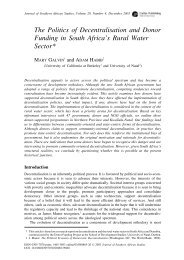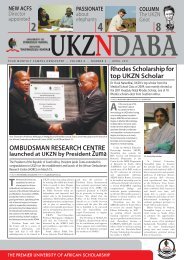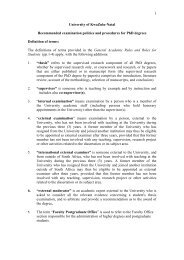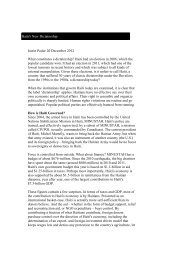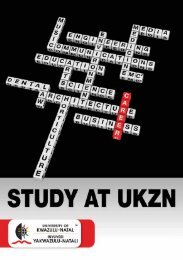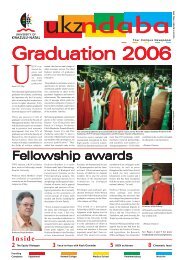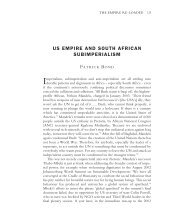Land Reform in South Africa: An Overview - Centre for Civil Society
Land Reform in South Africa: An Overview - Centre for Civil Society
Land Reform in South Africa: An Overview - Centre for Civil Society
You also want an ePaper? Increase the reach of your titles
YUMPU automatically turns print PDFs into web optimized ePapers that Google loves.
to the Restitution of <strong>Land</strong> Rights Act [FN29] has been passed giv<strong>in</strong>g the M<strong>in</strong>ister the power toexpropriate land <strong>for</strong> restitution without hav<strong>in</strong>g to get a court order. Previously, the Act provided <strong>for</strong>expropriation of land <strong>for</strong> restitution where the <strong>Land</strong> Claims Court had ordered the state toexpropriate land <strong>for</strong> the purpose. Although noth<strong>in</strong>g stopped the state expropriat<strong>in</strong>g <strong>in</strong> terms ofsection 25(2) of the Constitution, the Amendment Act makes the matter much clearer. TheAmendment should <strong>in</strong>deed allow the acquisition of land to proceed much faster where thelandowner is refus<strong>in</strong>g to negotiate. There is still scope <strong>for</strong> landowners to frustrate the process bychalleng<strong>in</strong>g the amount offered as compensation <strong>in</strong> the <strong>Land</strong> Claims Court. However, s<strong>in</strong>ce theexpropriation *293 becomes effective at the time of a valid expropriation order by the M<strong>in</strong>ister, theAmendment still takes the process <strong>for</strong>ward. What rema<strong>in</strong>s is to see whether the state is seriousabout expropriation and has the political will to proceed or whether it is only a threat to get thelandowners talk<strong>in</strong>g. What is necessary is a few expropriations to send a clear message to whitefarmers that government is serious. Be<strong>for</strong>e the "fast-track" land acquisition <strong>in</strong> Zimbabwe got out ofhand, this k<strong>in</strong>d of strategy had worked <strong>in</strong> gett<strong>in</strong>g farmers talk<strong>in</strong>g and negotiat<strong>in</strong>g seriously with thestate.Fourthly, there is the problem of f<strong>in</strong>anc<strong>in</strong>g the program. Although the state has already spent overthree billion rand on restitution, the Commission requires more billions to pay <strong>for</strong> land, providecompensation but also to pay <strong>for</strong> the consultants that assist the commission <strong>in</strong> validat<strong>in</strong>g theclaims and carry<strong>in</strong>g out the valuations of claims and the land. Given the other priorities of the statesuch as education, health and hous<strong>in</strong>g, the treasury is hard-pressed to provide the money. [FN30]Nevertheless, the budget <strong>for</strong> restitution, has been substantially <strong>in</strong>creased s<strong>in</strong>ce 2003 and thegovernment seems determ<strong>in</strong>ed to complete the process.How Effective Will Restitution be as a Contribution to the Correction of theInequitable Distribution of <strong>Land</strong> <strong>in</strong> <strong>South</strong> <strong>Africa</strong>?At the end of the restitution process when all the 79,694 [FN31] claims havebeen settled, a large proportion of the agricultural land <strong>in</strong> <strong>South</strong> <strong>Africa</strong> willstill be <strong>in</strong> the hands of a few thousand white farmers and cannot be dependedon either to br<strong>in</strong>g about equity <strong>in</strong> the distribution of land or to alleviatethe overcrowd<strong>in</strong>g <strong>in</strong> the rural areas and the urban townships. As of 29 February2004, with 61% of the claims settled, 810 292 hectares have been transferredto an estimated 616429 beneficiaries. [FN32] This is a significant achievement<strong>in</strong> *294 process<strong>in</strong>g of the claims, especially s<strong>in</strong>ce 2000. A number ofcommunities, which were brutally moved under apartheid, have been able toreturn to their ancestral lands. However, even double the amount of land sofar restored would still be about 1.6 million hectares, which is only 2% ofthe land held by white commercial farmers. [FN33] The majority of claimssettled so far (about 88%) are urban claims <strong>in</strong>volv<strong>in</strong>g small plots of land.About 35% of these have been settled with the restoration of land while about60% were awarded f<strong>in</strong>ancial compensation and the balance alternative remedy.[FN34] Thus, not much land has changed hands <strong>in</strong> the urban areas. As far asrural areas are concerned, most of the rural claims <strong>in</strong>volv<strong>in</strong>g thousands ofhectares and represent<strong>in</strong>g thousands of claimants are still to be settled.[FN35] Although the statistics show that about 46% of the rural claims settledhave been settled with restoration of land, [FN36] it is not clear how muchland rema<strong>in</strong>s under claim. It is regrettable that more rural claims have beenpage 6 of 28




